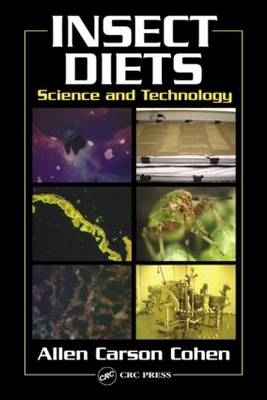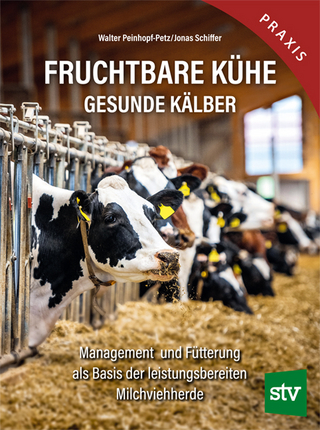
Insect Diets
Crc Press Inc (Verlag)
978-0-8493-1577-0 (ISBN)
- Titel erscheint in neuer Auflage
- Artikel merken
Many of the advances in entomology during the past century can be attributed to the ability to rear insects successfully on artificial diets. Reliance upon these diets dictates that we understand how and why diets work and why they fail. Insect Diets: Science and Technology explains the intricacies and dynamics of this complex and misunderstood aspect of entomology.
This text discusses the various ingredients and processing steps of successful diets. It details various nutrient classes and explains how the constituent parts of diets meet insect nutritional and feeding needs. The author examines diets in terms of overall insect biology, and explores the physical and chemical interactions of food components. This book offers an expert perspective on diet development and how a program of food quality assessment can be applied to rearing systems.
Drawing heavily on the field of food science, the book applies the vast resources, information, and methods of this discipline toward a full analysis of the preparation of insect diets, an analysis that serves as a valuable resource in the advancement of entomology.
THE SCOPE OF INSECT DIET SCIENCE AND TECHNOLOGY
Introduction
Food Science & Food Technology & Insect Diet Programs
The Subdisciplines of Food Science and Technology
The Diet in the Context of a Rearing Facility
Selected Books & Journals Food Science & Food Technology
Books on Food Processing:
Books on Food Chemistry
Books on Food Microbiology
Journals
DIET TERMINOLOGY & HISTORY OF INSECT DIET SCIENCE
Introduction to Diet Terminology
Historical Aspects of Insect Diet Science and Technology
Other Historical Diets & Significant Concepts
The Function of Insect Diet Components
Introduction to Functional Aspects of Diet Components
Essential Versus Non-Essential Nutrients
Purpose of Individual Diet Ingredients & Nutrient Functions
Minerals
Feeding Stimulants
Protective Ingredients
"Nutritionally Inert" Ingredients Provide Texture
Importance of Ph and its Influence on Diets
Water Content (Percentage) and Water Activity (Aw)
Nutritional Profile of 5 Diet Prominent Components
Overview of Diet Additives
Emulsifiers
Gelling Agents and Stabilizers
Antioxidants
Antimicrobial Agents
Flavoring Agents
Colorizing Additives
Bulking And Texturizing Agents
Chelating Agents
WHAT MAKES A DIET SUCCESSFUL OR UNSUCCESSFUL?
Overview
The Terminology Regarding Success and Failure Of Diets
Minimal Nutrients (The "Simple Nutrient" Model)
The "Minimal Nutrient" Concept
The Rules of Nutrient Sameness, Nutrient Proportions, And Cooperating Supplements
Examples Of Excellent Diets & Why They Are Successful
Vitamin and Mineral Souces in Successful Diets
The Issue of Bioavailability
THE CHEMISTRY AND PHYSICS OF INSECT DIETS
Introduction to Diet Chemistry and Physics
Bioenergetics and The Nature of Energy in Insect Diets
The Nature of Water and What it Means to Insect Diets
The Nature Of Ph And How it Affects Diet
Oxygen & Reactive Oxidative Species (Ros) Present in Diets
The Factors that Affect Diet Texture
Processing History of Diets: Physical Qualities of Diets
The Chemistry of Proteins and Amino Acids In Diets
The Chemistry of Lipids in Insect Diets
The Chemistry of Carbohydrates in Diets
The Chemistry of Nucleic Acids in Diets
The Chemistry of Vitamins in Diets
DEALING WITH CHANGES
Introduction
Confusion over Product Name Differences
Unavoidable Changes in Diets and Other Components
Changes in Production Procedures
What To Do If You Must Make Changes
Making Changes: Developing Strategic Planning Systems
Testing Changes: The Hallmark of Stable Rearing Programs
Using the Ingredient Cycle Concept
INSECT FEEDING BIOLOGY (DIGESTIVE SYSTEM ANATOMY & ULTRASTRUCTURE, PHYSIOLOGY & BIOCHEMISTRY OF DIGESTION, FEEDING BEHAVIOR, AND SENSORY SYSTEMS) AND THE LOGIC OF METABOLIC SYSTEMS
Introduction and Overview of Insect Feeding Systems
Insect Feeding Habits:
Pre-Ingestion and Post-Ingestion Processing
Liquids And Solids And Slurries, Oh My!
The Insect Gut: A Study in Compexity
Mean Retention Times and Diet Composition
Regulation of Digestive Function
Structure & Organization of Insects' Digestive Systems
Macromolecular Complexes-Macromoleucles-Large Subunits-Simple Molecular Subunits
Metabolic Logic: What Happens To Food Components after Insects Consume Them
ORDER IN NATURE AND COMPLEXITY IN INSECT DIETS
Introduction to Order and Complexity
Orderliness of the Systems Where Insects Feed in Nature
Factors that Cause Complexity in Diets
The Paradox of Nutrients and Anti-Nutrients
Unexpected Changes after Management Decisions
Complexity Can Come from Both Conscious Decisions and From Hidden Factors
Changes in the Order or Nature of Processing Steps
The Many Facets of Iron as an Illustration of the Concept Of Complexity in Insect Diets
NUTRITIONAL ECOLOGY AND ITS LINKS WITH ARTIFICIAL DIETS
Introduction to Nutritional Ecology and Artificial Diets
Nutrients & Antinutrients in the Foods of Insects
Plant Secondary Compounds, Feeding, & Artificial Diets
The Efficiency Indices
Sifting Through the Functional Role of Components
Artificial Diets as Delivery Systems for Testing Anti-Nutrients & Toxins
HOW TO DEVELOP ARTIFICIAL DIETS
Difficulties in Diet Development Methodologies
Starting Out: The First Steps in Diet Development
Using Diets Developed for Insects with Similar Feeding Habits
Use of Food Analysis as a Basis for Diet Development
Use of Whole Carcass Analysis in Diet Development
Radioisotopes & Diet Deletion Techniques
Use of Digestive Enzymes as Aids in Diet Development
Nutrient Self-Selection
The Eclectic Approach
Development of Minimal Daily Requirements (Mdr)
DEVELOPMENT OF PROBLEM SOLVING STRATEGIES, QUALITY ASSESSMENT, QUALITY CONTROL STANDARDS, AND SOPS
Introduction to Diet Problem Solving and Quality Control
The Over-All Rearing System.
Logistical And Statistical Background: Process Control And The Qc Environment
Quality Control and Quality Assessment Of Insects And Insect Diets
Quality Loss in Insects Reared on Artificial Diets
Quality Control of Diets
Quality Measurement of Insects: The Importance of The Bioassay as a Quality Assessment Tool
Measurement of Whole Diet & Component Quality
EQUIPMENT USED FOR PROCESSING INSECT DIETS: SMALL, MEDIUM, AND LARGE SCALE APPLICATIONS
Introduction
Applications of The Geometry Of Scale: Heat Exchange in Diet Processing
General Small Scale Processing
Medium to Large Scale Diet Processing
Water Purification and Water Quality
Storage of Ingredients and Completed Diets
Standards of Acceptable Quality
Ultra-Low Temperature Storage
Size Reduction of Ingredients
Size Reduction of Meat Products And Eggs
Size Reduction in Plant Materials
Mixing
Heat Processing
Case Study: Packaging and Containerization
Future Prospects
MICROBES IN THE DIET SETTING
Overview of Microbe/Insect Interactions in the Rearing Setting
Mutualism and Commensalism: Microbes that Have Beneficial or Neutral Relations with Insects
The Microbiology of Foods and Insect Diets
Using A Mixture of Two or More Kinds of Preventative Actions to Reduce Microbial Contamination
Common Contaminants in Insects, Insect Diets, and Rearing Settings
Other Techniques Used to Remove, Reduce, or Ameliorate Microbial Contaminants
Cold Techniques
Chemotherapy and Chemical-Based Prophylaxis
Physical/ Radiation Techniques
De-Contaminantion Procedures Can Deteriorate Diet Quality
Finding a Safe Middle Ground: Optimizing and Balancing Microbial Contaminant Treatments with Insect Well-Being
Future Prospects in the Microbiology of Insect Diets: Probiotics, Prebiotics, & Novel Antimicrobials
Studies of Biofilms
Integration of Food Industry Sanitation with Insect Diet Production
SAFETY AND GOOD INSECTARY PRACTICES
Introduction: Safety and Good Insectary Practices Are Completely Congruent
Chemical Hazards
Proper Storage and Disposal Of Potentially Hazardous Chemicals
Microbial Hazards and Other Biological Hazards
The Special Issue of Smoking In Conjunction with Rearing
Mechanical and Thermal Hazards
Electrical Hazards
In General
FUTURE PROSPECTS FOR INSECT DIETS: INTRODUCTION
Application of Food Science & Food Technology Principles
Progress in Equipment Applications
Food Matrix Analysis
Development of Symptomology of Nutritional Deficiencies
Development of Highly Refined Bioassays
Application of Fermentation and Gmo Technology
Advanced Technologies for Detecting & Handling Microbial Contaminants
Advancements in Techniques to Characterize the Species and Nature of Symbionts
Application of Advanced Nano-Analysis Techniques for Nutrient Evaluations on an Ultra-Small Scale
Application of Research Techniques with Advanced Microscopy Tools
The 21st Century Insect Diet Professional: Suggestions for a New Curriculum and Educational Profile
The 21st Century Insect Diet and Rearing Professional: A Formal Professional Standing
APPENDICES
Glossary of Diet and Diet-Related Terms
Historical Landmarks in Insect Diets and Events that Set the Stage for Diet Advancements
History of Artificial Diets for Insects and Events of Significance to Diet Related Insect Rearing
Vitamin and Mineral Mixtures Commonly Used in Insect Diets
Quality Assessment of Microbial Counts in Rearing Facilities, Diet Components, and Finished Diets
Quality Control of Environmental Parameters
Explanations of Accuracy and Precision in Measuring Diet Components
Bioassays in Diet Development, Quality Control, and Testing Effects of Additives
| Erscheint lt. Verlag | 20.10.2003 |
|---|---|
| Zusatzinfo | 52 Halftones, black and white; 41 Tables, black and white; 106 Illustrations, black and white |
| Verlagsort | Bosa Roca |
| Sprache | englisch |
| Maße | 178 x 254 mm |
| Gewicht | 771 g |
| Themenwelt | Naturwissenschaften ► Biologie ► Zoologie |
| Veterinärmedizin ► Allgemein ► Tierernährung / Tierhaltung / Tierzucht | |
| ISBN-10 | 0-8493-1577-8 / 0849315778 |
| ISBN-13 | 978-0-8493-1577-0 / 9780849315770 |
| Zustand | Neuware |
| Haben Sie eine Frage zum Produkt? |
aus dem Bereich



